Top Tips for Hiking and Backpacking on the Oregon Coast
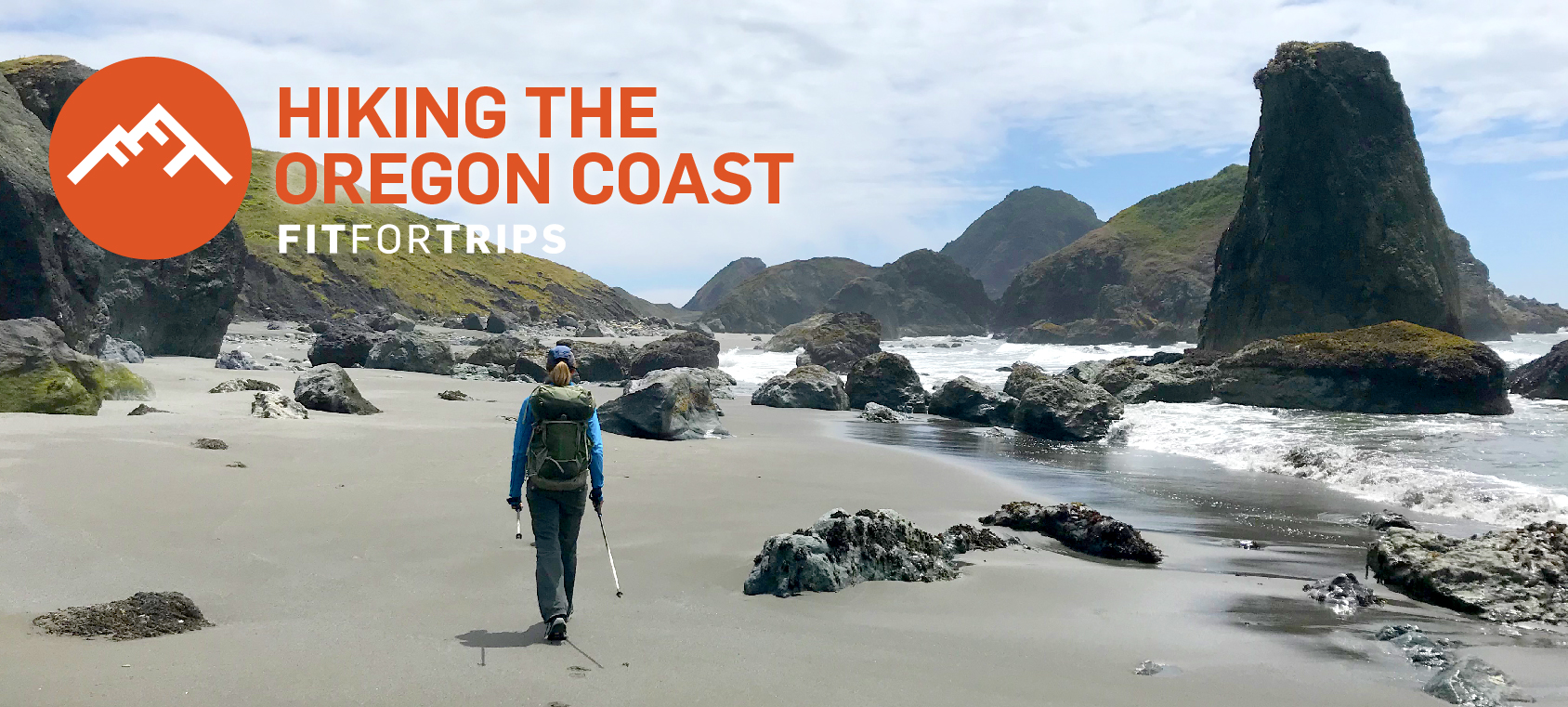
When planning a hiking trip to the Oregon coast, there’s much to consider. We checked in with Bonnie Henderson, author of “Day Hiking: Oregon Coast” and “Hiking the Oregon Coast,” for everything you need to know about the best places to hike along Oregon’s coast, as well as hiking and backpacking the Oregon Coast Trail (OCT). She offers tons of tips and personal insight that will inspire you to add hiking the Oregon Coast to your adventure list.
The OCT knits together nearly 400 miles of trails through towns, state parks, and beaches. While some of the scenic stops and towns are ideal for visitors looking for attractions and day hikes on the Oregon coast, many of these suggestions are also relevant for people backpacking the Oregon Coast Trail. We’ve explicitly noted those places that aren’t directly on the OCT, but are still somewhat accessible to distance hikers looking to get the most out of their trip.
From rocky vistas to idyllic coastal towns, all connected by an impressive long trail that weaves in and out of sandy beaches and beautiful forests, Oregon coast hiking trails offer a unique experience for hikers and backpackers to enjoy. Due to the unique challenges that the varied terrain can present, physical preparation and training will go a long way in enhancing the experience. Check out Fit For Trips’ custom training programs or schedule a complimentary fitness consultation with Marcus Shapiro.
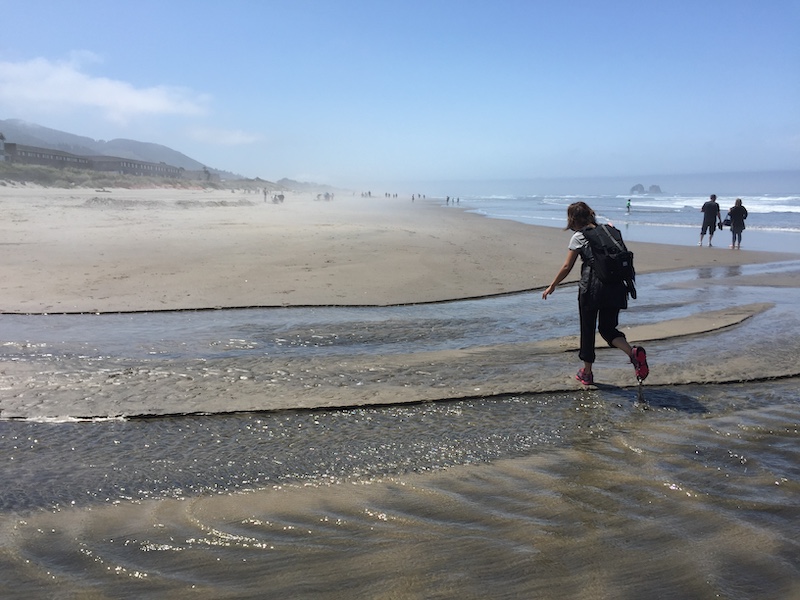 Hiker jumping over streams near Rockaway Beach along Oregon Coast Trail.
Hiker jumping over streams near Rockaway Beach along Oregon Coast Trail.
Recommended Oregon Coast Books Written by Bonnie
You can buy Bonnie’s hiking books from any book retailer. If you live along the Oregon coast, or are in the area for a visit, these books can be found at bookstores and interpretive centers along the trail, including Beach Books (Seaside), Cannon Beach Book Company, and Gold Beach Books.
Hiking the Oregon Coast Trail
Check Price: REI
This book is for hikers who plan either to section hike or to start at one end and backpack the entire Oregon Coast Trail. Backpackers experience logistical issues that day hikers don’t have, for instance: Where am I going to camp? What are my options for going to the bathroom? Where am I going to get water? These are all things that are a little bit tricky when you’re a backpacker on this particular trail. This book helps solve those problems.
I wrote this book because I wanted people to have a good experience on the trail. There is no other book that specifically addresses the needs of backpackers on the Oregon Coast Trail. The trail has been slowly developing, and it has been slowly developing an audience. Efforts to improve the trail and cut down on road walking sections are continuing. And I just felt like it’s time for people to have a guide to get out there and help them have a really good experience on it.
Day Hiking the Oregon Coast
This book is ideal for day hikers looking for insider tips on where to find amazing trails and beaches to explore on the coast of Oregon. There are incredible dunes to hike through, plus so many great headland trails. There are places where you can do loop trails that’ll incorporate the beach and the forest. The Oregon coast is really a hiker’s paradise.
I first proposed this book to my publisher because the only book about hiking on the Oregon coast available at the time was not great. It hadn’t been updated for years, and frankly, it had a lot of inaccuracies. So, I wanted to write a good book to help people know where to go and have a good experience hiking on Oregon’s coast.
Best Hikes with Kids: Oregon
Check Price: REI
Kids tend to be less impressed by views than adults. I spent time looking for fun little experiences that kids will love. This book offers more than 80 hikes throughout the state that have things to engage children, including little bridges, waterfalls, and other fun things to see. I’ve included details on the plants and animals you might see, and fun activities to do on the trail. The hikes in this book range from easy to difficult for children, go up to 6 miles in length, and feature optional turnarounds for tired feet.
There are hikes for children all over Oregon, but there are so many great accessible hikes at the coast. What’s great about the coastal hikes is that there aren’t any really horrendous ascents. There are uphill hikes, of course, and kids can hike uphill. However, it doesn’t take much to get to a place with a lot of variety to appeal to children and a great view for adults to enjoy.
Hiking on Oregon’s Coast
What makes Oregon unique is the Oregon Beach Bill, which passed in 1967. This bill that made all of Oregon’s coast, up to the vegetation line, public space. So, we have this great resource of public beaches, and then we have these existing trails over headlands. Those individual trails have been linked together to create the Oregon Coast Trail. You can day hike, section hike, or thru-hike the various trails on Oregon’s coast.
So, when you talk about day hiking on the coast of Oregon, there a million places to hike in the vicinity. Oregon has 363 miles of coastline, and 262 miles of it is sandy beach, so you can do a lot of beach walking. Also, there are state parks and scenic corridors all down the coast with maintained trails for hiking. Most of them were established as early as the 1920s, and they’ve grown since then. Most of the major headlands have trails on them, and they’re typically forested and beautiful. So, there are a lot of places to day hike on Oregon’s coast.
Many people discover the OCT when researching where to hike or backpack on Oregon’s coast. This long trail knits together the sandy beaches along the coast, dipping in and out of the forest, and uses trails established through the state parks. The Oregon Coast Trail is essentially a continuous walking route from the Columbia River in the north, all the way down to the California border.
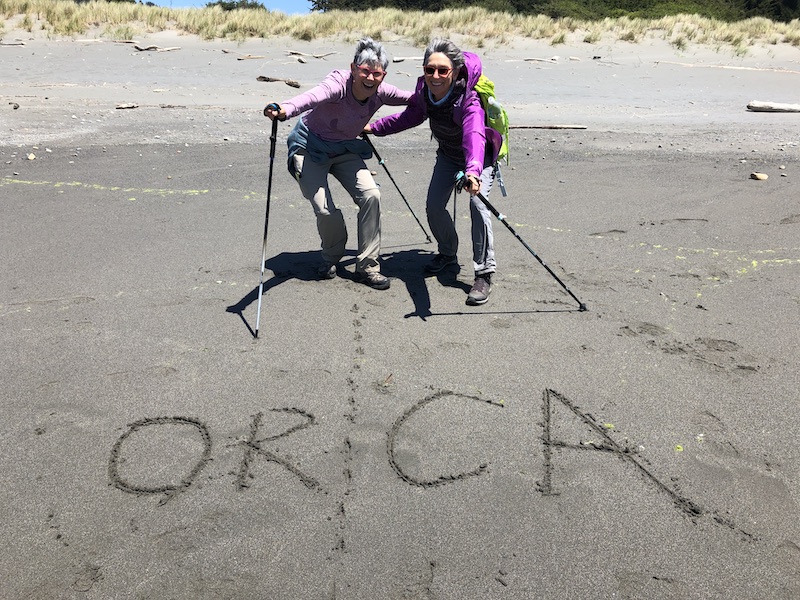 Hikers celebrating reaching Oregon/California state line south of Brookings.
Hikers celebrating reaching Oregon/California state line south of Brookings.
Best Oregon Coast Hikes
It’s important to note that the hikes mentioned here can be day hikes, but they are also sections of the Oregon Coast Trail. As a result, these suggestions are relevant for section hikers and thru-hikers who are backpacking on the Oregon Coast.
Top 3 Most Beautiful Hikes on Oregon’s Coast
- Cape Lookout State Park has some of the most beautiful hiking in coastal Oregon. When people ask me what my favorite is, my first thought is always the trail on Cape Lookout. You can see far up the coast in both directions. It’s just an absolutely spectacular spot. When you get to the end, you’re quite high, peering over cliffs that go straight down into the ocean. I have seen whales from that lookout point. I’ve heard other people have seen whales just lounging at the bottom of the cliff there. They hang out there because the water is really deep.
- Start at the Columbia River, which is the beginning of the trail, and just hike south for 16 miles on the beach with no interruptions. You can’t do that very many places, and the walking is really good. There are several beach access points along it so you can hike as far as you like. You don’t have to worry about the tide because the beach is super wide. It’s pretty cool, you can walk by a 1906 shipwreck still resting on the beach. This is one of my favorite parts of the trail to section hike, though there are 3 miles in the middle, north of Sunset Beach State Recreation Site, that are sometimes closed to public access by the adjacent National Guard training camp.
- Carl G. Washburne Memorial State Park on the Central Coast is another cool place to hike. This is a really lovely part of the Oregon Coast Trail, but it’s also a great place for day hiking. You can do some really cool loop hikes that include both the beach and the forest, so you get variety. It is adjacent to another state park that includes Heceta Head, which has a really cool lighthouse from the late 1800s. When you hike up over the headland you actually get above the lighthouse, then you walk down to it.
 On the Oregon Coast Trail north of Florence looking at Heceta Head Light House.
On the Oregon Coast Trail north of Florence looking at Heceta Head Light House.
Oregon Coast’s Top 3 Challenging Sections to Hike
- Boardman State Scenic Area, which is way down south, almost at the southern terminus. It is a great area to hike. It’s absolutely beautiful, but it’s constantly up and down. The OCT is not a tough trail, generally speaking, but this section through Boardman is challenging if you’re doing the whole thing in one day because of the terrain and limited camping options. For those thru-hiking or section hiking, it just makes for a long day.
- Bandon to Floras Lake, on the South Coast, is the toughest section, in my opinion. I think it’s difficult for a few reasons. First, the texture of the sand makes things challenging because the grains are larger, so the sand is very soft. Second, the beach is narrow and slanted, and pair that with soft sand and it just takes a lot of effort to walk. It’s very remote, so you’re unlikely to see anybody else on the beach for this really tough slog. Finally, it’s tricky because you have got to hit the mouth of New River at low tide or you won’t be able to cross it. Timing is important.
- Winchester Bay to Coos Bay, which is just south of the midpoint of the trail. This one is challenging because it’s long and kind of boring. The scenery doesn’t change much. Plus, you might run into people with off-highway vehicles, which you don’t usually see on other parts of the Oregon Coast Trail. A friend who has hiked the OCT with me said this was her least favorite part.
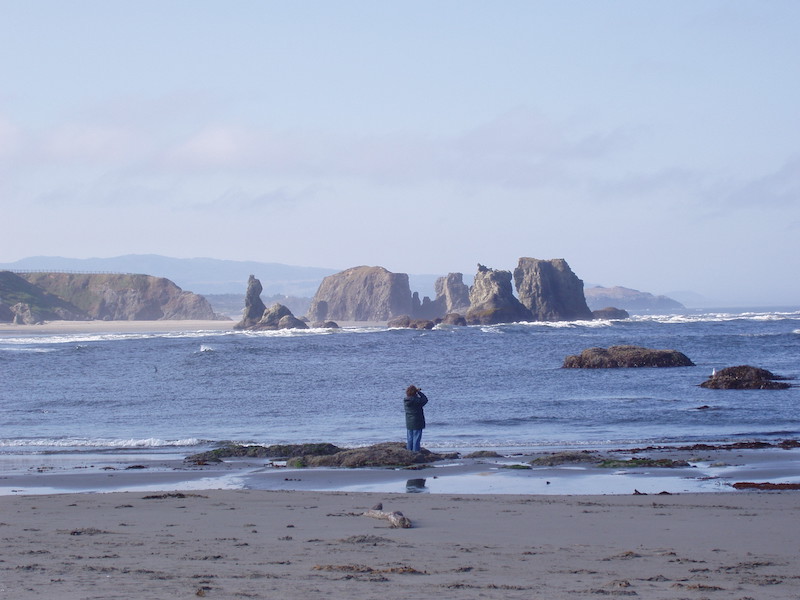 Offshore sea stacks south of the town of Bandon, on the Oregon Coast.
Offshore sea stacks south of the town of Bandon, on the Oregon Coast.
Must-Visit Spots on the Oregon Coast
Oregon’s Best Coastal State Parks
There are dozens of incredible state parks in Oregon, and many of my favorites make it so easy to find great hiking near Oregon’s coast. However, I love to suggest these four state parks for visitors.
- Ecola State Park is located on the North Coast. This state park includes Tillamook Head, which is a beautiful headland between the towns of Seaside and Cannon Beach. Headlands are high coastal landforms that drop into the ocean, and can offer views of secluded bays and beach areas. This park has an 8-mile segment of the Oregon Coast Trail running through it. South of the headland, there’s more forest adjacent to the beach that has some lovely trails for hiking. It’s just a gorgeous park.
- Oswald West State Park is popular north-coast park because it’s home to Short Sand Beach, one of the state’s most popular surfing beaches. It has headlands, beaches, and the forest has some very, very old cedars growing in it. This is special because there are not a lot of these beautiful, remnant old-growth forests on the coast. The North Coast Land Conservancy acquired 3,500 acres of a fabulous, mountainous territory adjacent to the state park. In a sense, that acquisition kind of amplified the impact of this state park quite a bit. Plus, this park has a 13-mile section of the OCT traversing through it.
- Cape Lookout State Park extends a rocky finger a couple of miles straight out into the ocean. This one is also on the North Coast, and the hiking there is wonderful. Depending on the time of year and how well the weather cooperates, hiking out to the end can be a great spot for whale watching. Cape Lookout isn’t part of the Oregon Coast Trail because the trail goes up and over the Cape. However, if you are hiking the OCT and you have the time, this state park is a great detour.
- Cape Sebastian Scenic State Corridor is another lovely state park to visit on the South Coast. Cape Sebastian is a big headland with a trail that goes over it. The north half of the trail isn’t as well maintained as the trails on the northern coast because there aren’t as many people on it. However, it’s a really cool headland with great hiking on it.
 Hiker uses rope to descend the last few steps at the end of the trail over Cape Sebastian.
Hiker uses rope to descend the last few steps at the end of the trail over Cape Sebastian.
 Gigantic Sitka spruce alongside the Oregon Coast Trail, over Tillamook Head, south of Seaside.
Gigantic Sitka spruce alongside the Oregon Coast Trail, over Tillamook Head, south of Seaside.
Oregon’s Best Coastal Towns
If you like having relatively easy access to amenities such as restaurants and other activities while hiking on the Oregon coast, these coastal towns are worth a stop.
- Cannon Beach is a really fun town just south of Ecola State Park. There are lots of great places to eat, drink, grab coffee, whatever, and it has lots of great lodging. Cannon Beach is right off the OCT for those who want to get off the trail to enjoy some amenities.
- Newport is another really great town to visit. It’s at the north end of central Oregon coast. You’ve got the National Oceanic and Atmospheric Administration’s Marine Operations Center and their Pacific fleet docked there. The Hatfield Marine Science Center, part of Oregon State University, is also in town. Newport has good restaurants and great places to stay if you want to do an overnight.
- Port Orford is a very small town, only about a block long, on the South Coast. There’s a great chowder shop there and Redfish, a really nice restaurant with a view. What’s unique about Port Orford is their fishing port, where boats are kept in dry dock at all times. Cranes are used to put the boats in and out of the water. Fishermen will come back in the afternoon, have their boat removed from the water by crane, and then they’ll unload their catch. It’s pretty interesting to watch. I really like this town.
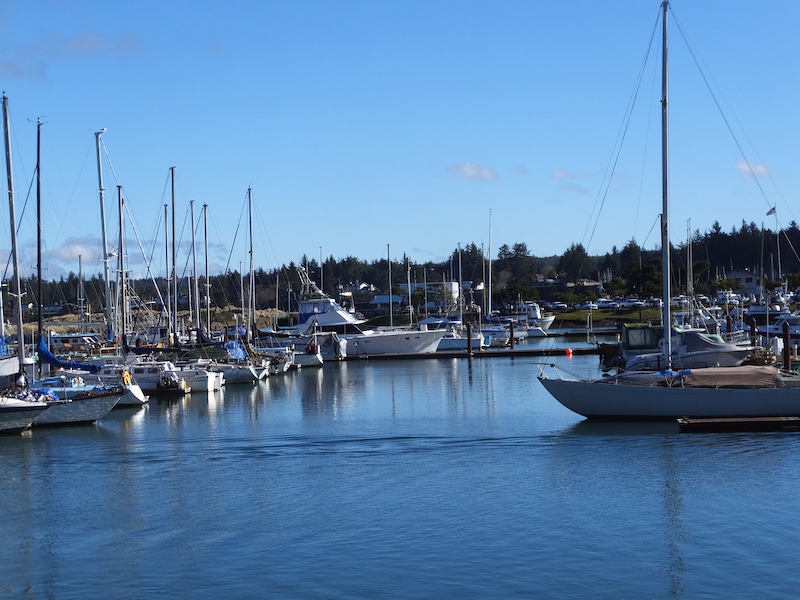 Charleston Marina on Coos Bay, adjacent to the Oregon Coast Trail.
Charleston Marina on Coos Bay, adjacent to the Oregon Coast Trail.
Iconic, Natural Features Worth Seeing
Whether you’re planning to hike or drive, there are some beautiful, natural features along Oregon’s coast that are worth planning into your itinerary. These are my favorites that I love to suggest for visitors.
- Samuel H. Boardman State Scenic Corridor is one of my favorite places because it has these amazing, natural features. I suggest parking your car and hiking a short distance on any of the little trails that go through the forest out toward the shoreline. You’ll see magnificent rock arches, natural bridges, and little secret beaches. It’s a gorgeous, sort of hidden coastline within this scenic park on the South Coast.
- Cape Perpetua Scenic Area is located within Siuslaw National Forest. The cape itself is a high point along the coast, standing at 800 feet above the Pacific Ocean, and has these beautiful views of the water and the road winding in and out of the forest. It’s easily accessible for cars, but it also features 26 miles of trails. What I think is really neat about the shoreline there is it has lots of really cool formations in the rocks. This is also one of the places where water shoots up through rocks or churns in a narrow chasm. Devil’s Churn is one of those amazing, must-see spots that is most dramatic in winter.
- Proposal Rock is an off-shore sea stack located near the town of Neskowin. When tide is low, you can walk all the way around it and see the ghost forest of old trees that were submerged under the ocean’s tide. There’s really great sea life clinging to the rocks, especially on the back side. Even during higher tide, it’s a cool place to visit, and it’s very easy to get to.
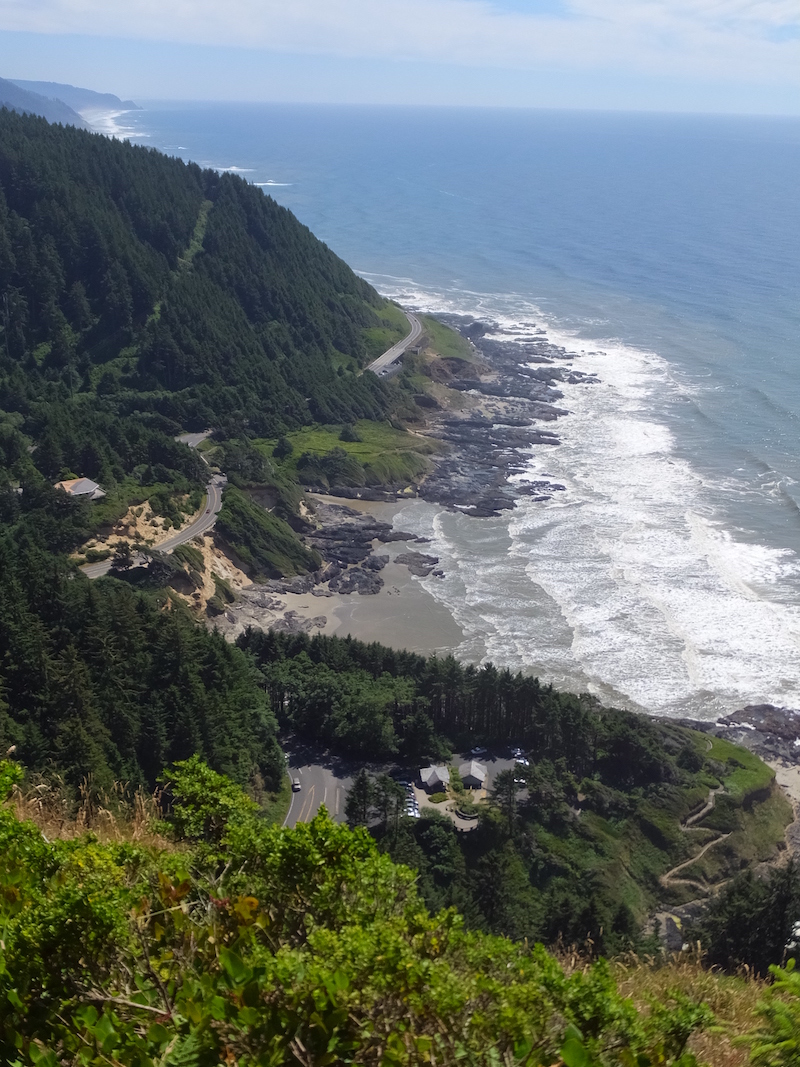 View south from the top of Cape Perpetua, south of Yachats.
View south from the top of Cape Perpetua, south of Yachats.
Debunking Myths About the Oregon Coast Trail
These are the common assumptions that people make about the Oregon Coast Trail:
- It’s mostly on the highway,
- It’s half on the highway, or
- It’s around 40% on the highway.
None of these misconceptions about the OCT are true. Here’s a more realistic breakdown of the Oregon Coast Trail:
- Nearly half of the OCT is right on sandy beaches.
- Around 25% of it is on trails.
- Around 25% of it is on roads, and half of those roads are quiet back roads; the other half is on the shoulder of US 101. You can shorten that if you get boat rides across bay mouths or bus rides around bays or on long highway stretches.
What many people don’t realize is that even in less remote parts of the OCT, where you’re walking the beach and the highway is right next to you, you don’t even notice because the ocean is roaring in your ears all the time.
 Cape Kiwanda beach, near Pacific City along Pacific Coast Trail.
Cape Kiwanda beach, near Pacific City along Pacific Coast Trail.
Backpacking the Oregon Coast Trail
How Long Does It Take to Thru-Hike the Oregon Coast Trail?
Unless you’re going to take a lot of zero/layover days, it typically takes less than a month. Theoretically, you could take as much time as you want and just hike a little bit every day. Although, because there are limited places to camp, you’re going to end up hiking some long days. And by long, I mean, you should be prepared to be able to hike 15 miles a day. You won’t need to do that every day, but given that, it will take you three or more weeks to hike the entire trail start to finish.
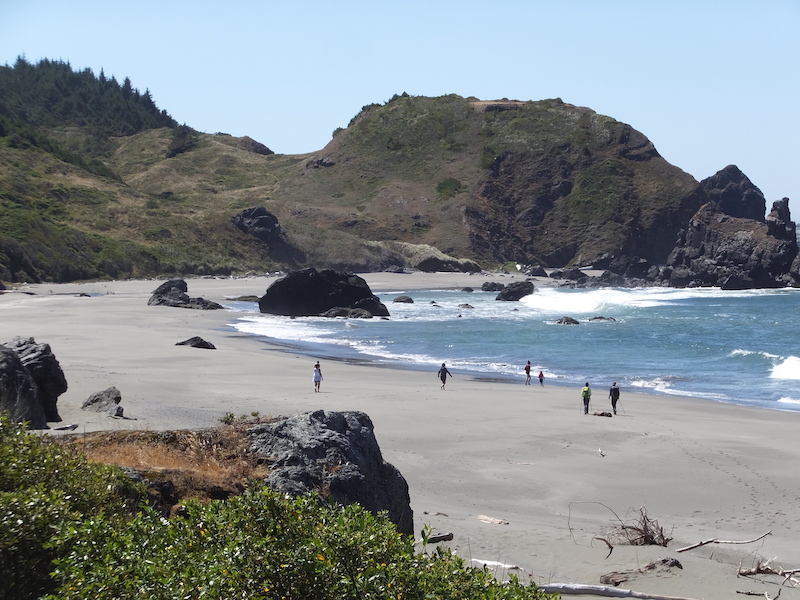 Lone Ranch Beach near the end of Oregon Coast Trail, approaching town of Brookings.
Lone Ranch Beach near the end of Oregon Coast Trail, approaching town of Brookings.
Best Time of Year to Thru-Hike the OCT
This is a really important question, and the answer is multi-faceted.
With regards to weather, you could start in April or May. Although, you’ll want to avoid southwestern winter storms, which start in October and can go through March. These big storms can be really dangerous on headlands, when the wind is blowing trees over. The best time of year to backpack the OCT, weather-wise, is June through September.
The real limiting factor on the Oregon Coast Trail is the river levels. On the South Coast, south of the town of Florence, there are many river mouths that you have to wade at low tide. In winter months they’re too high to wade through. Alternatively, on the North Coast, there are no major rivers that you need to wade through that don’t have a nearby bridge to cross with.
I sort of did a little historical analysis. Typically, those southern rivers reach their summer levels in mid-June. As a result, I recommend people hike the Oregon Coast Trail from mid-June through September.
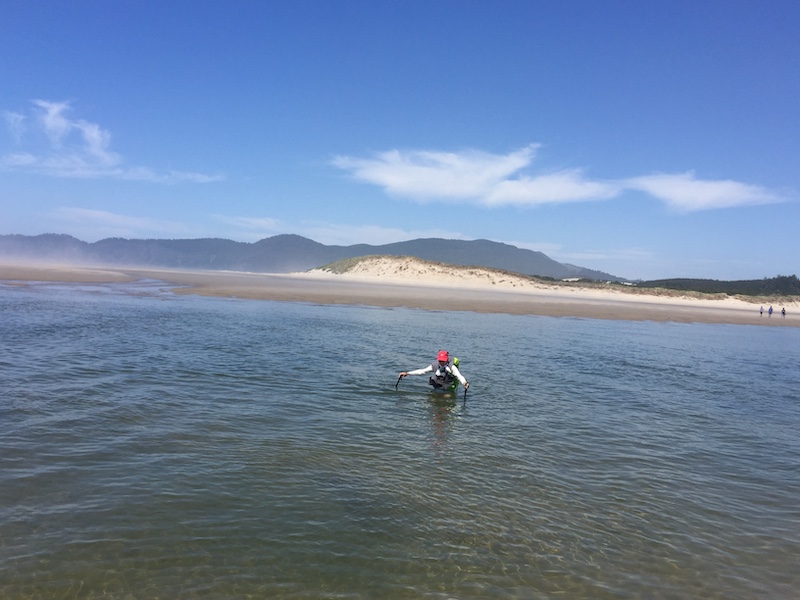 Wading the mouth of Sand Lake Outlet, walking north to south, just north of Pacific City.
Wading the mouth of Sand Lake Outlet, walking north to south, just north of Pacific City.
Ease of Planning to Thru-Hike the OCT
Compared to planning thru-hikes on other long trails in the United States, planning to backpack the Oregon Coast Trail is really easy. For example, when backpacking the Pacific Crest Trail, thru-hikers typically send themselves food packages at various stops along the way. They’ll have to hike into towns to pick up their food along the way, and sometimes they have to carry a lot between stops.
On the OCT, you never need more than two or three days, at most, worth of food. It’s because there are so many places to stop and get groceries, plus restaurants to stop for a meal. However, along the dunes and depending on how fast you’re hiking, you might need to backpack with a couple of days-worth of food. You’d just stock up in Florence and then you’re good for a few days.
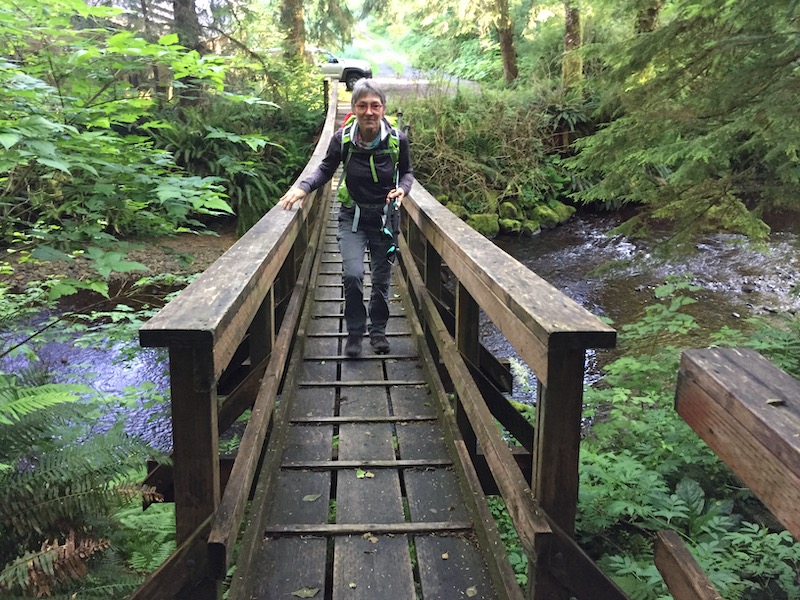 Suspension bridge over Arch Cape Creek, south of Cannon Beach, on the Oregon Coast Trail.
Suspension bridge over Arch Cape Creek, south of Cannon Beach, on the Oregon Coast Trail.
Section Hiking the Oregon Coast Trail
Best Time of Year to Section Hike the OCT
I would say just pick any time between mid-June and September, or earlier on the north coast if you like. The time of year doesn’t matter as much if you’re just backpacking a section of the Oregon Coast Trail that doesn’t have major river crossings, but winter can be really stormy and cold. Regardless of the time of year, always carry good rain gear.
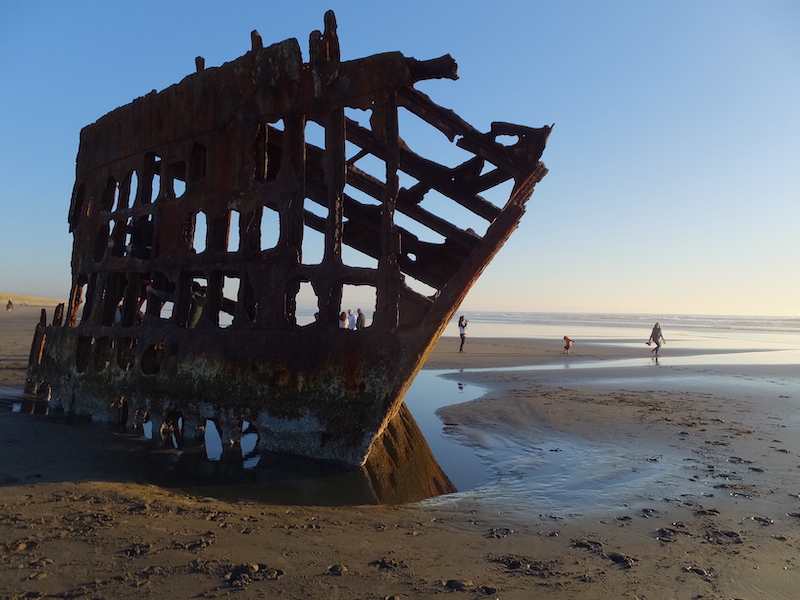 Remnants of British ship, the Peter Iredale, have been on the beach in Fort Stevens State Park since the ship ran aground in 1906.
Remnants of British ship, the Peter Iredale, have been on the beach in Fort Stevens State Park since the ship ran aground in 1906.
Best Section Hikes on the Oregon Coast Trail
I’m going to just name two sections for you based on how easy it is to access them from nearby airports.
- Start at the Columbia River at the northern terminus of the trail and hike south. You can fly into Portland International Airport, get a bus out to the coast and start at the Columbia River or at the campground in Fort Stevens State Park, and then hike south, maybe down to the town of Garibaldi, before taking public transportation back. I love that stretch. It’s the state’s longest beach, plus there are some beautiful headlands. There are a few places where you can get boat rides across river mouths.There are limitations on camping; be sure to check my book Hiking the Oregon Coast Trail and my website, hikingtheoct.com, for the latest intel on legal campsites. Also, this is one of the few places where you can camp on the beach, although with some limitations. So, I recommend flying in, camping for a few nights along this section of trail, and spending a night or two in Portland on either end.
- Bandon to Port Orford is a nice hike, and it’s accessible from Southwestern Oregon Regional Airport in North Bend, OR, by public transportation. I already told you that there’s a stretch south of Bandon that’s really a tough slog, but it’s just a few miles. Meanwhile, you’ve got a very, very remote stretch of beach all to yourself. It’s absolutely gorgeous, and there are some really great places to camp.You’ll hike past Floras Lake, which is a popular place to go kiteboarding in Oregon. You’ll hike to Blacklock Point, a totally undeveloped and remote state park, which is absolutely beautiful. You get to go to the town of Port Orford, which I’ve already mentioned. If continue a little further south, all the way to Humbug Mountain State Park, you can camp there overnight and then hike to the top of Humbug Mountain. I think that’s a really special part of the coast.
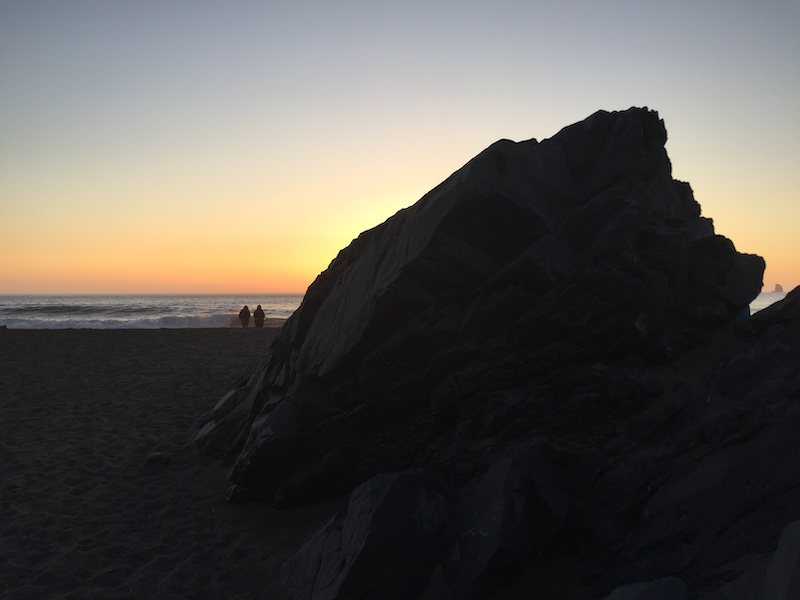 Sunset on the beach, north of Humbug Mountain and south of the town of Port Orford.
Sunset on the beach, north of Humbug Mountain and south of the town of Port Orford.
Oregon Coast Backpacking Basics
If you’re planning on backpacking the Oregon Coast Trail, whether thru-hiking or section hiking, here are some logistics to consider when camping on Oregon’s Coast and along the OCT.
Is the Oregon Coast Trail Safe?
The first time I hiked the OCT, I was in my 50s and hiked by myself. I never worried about my safety. I know lots of women and men who have done it by themselves, and they were not worried about it. Although, awareness is an important part of safety.
Some people worry about bad people doing bad things to them. Others worry about wild animals. There are small black bears, but they’re really not threatening. There are cougars around, but in recorded history, no one has been killed by a cougar on the Oregon coast. With all of the water features along Oregon’s coast, some people might worry about the getting swept out to sea at the mouth of a river; that’s a danger you can control by being careful about timing and not taking unnecessary risks. Despite all of these very common things to consider, I think the Oregon coast and the OCT are an extremely safe place to hike.
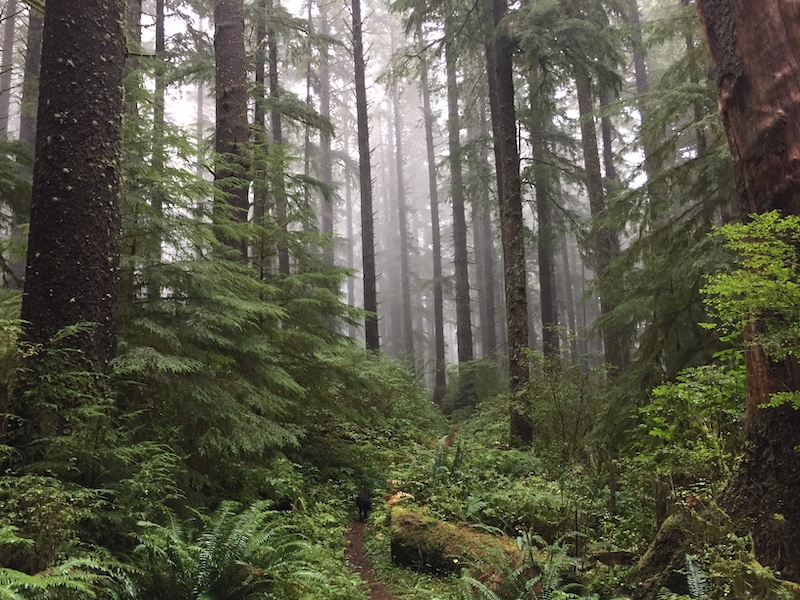 South Rainforest Trail that Oregon Coast Trail hikers follow over Cascade Head, is located north of Lincoln City.
South Rainforest Trail that Oregon Coast Trail hikers follow over Cascade Head, is located north of Lincoln City.
Camping on the Oregon Coast
So, I think when some people picture themselves hiking the Oregon Coast Trail, they expect to be camping on the beach every night. Probably not. While you can camp on the beach in Oregon, there are some really important limitations.
First is, most towns don’t allow people to camp adjacent to their city limits. Second, Oregon’s state parks don’t allow people to camp adjacent to state parks, whether or not those parks have campgrounds in them. Finally, the beaches have protected nesting sites from mid-March to mid-September for western snowy plover. So, there are parts of the coast where you can walk on the beach, but you’re not allowed to camp. That said, there are places where you can beach camp, but there are plenty of alternatives, too.
Biker/Hiker Campsites
Many people depend on a thing called hiker/biker camping. Every state park campground on the Oregon coast has a hiker/biker campsite. These sites are drop-in only and don’t take reservations. Reserved campsites at the coast often fill up quickly. It’s cheap, costing only $7-$9 per person per night and showers are included. Hiker/biker is a group camp area, so you’re camping with other people who are either cycling US Highway 101 or backpacking the Oregon Coast Trail. There aren’t enough of these hiker/biker locations to do it every night, but it kind of becomes the backbone of your backpacking experience on the Oregon Coast Trail.
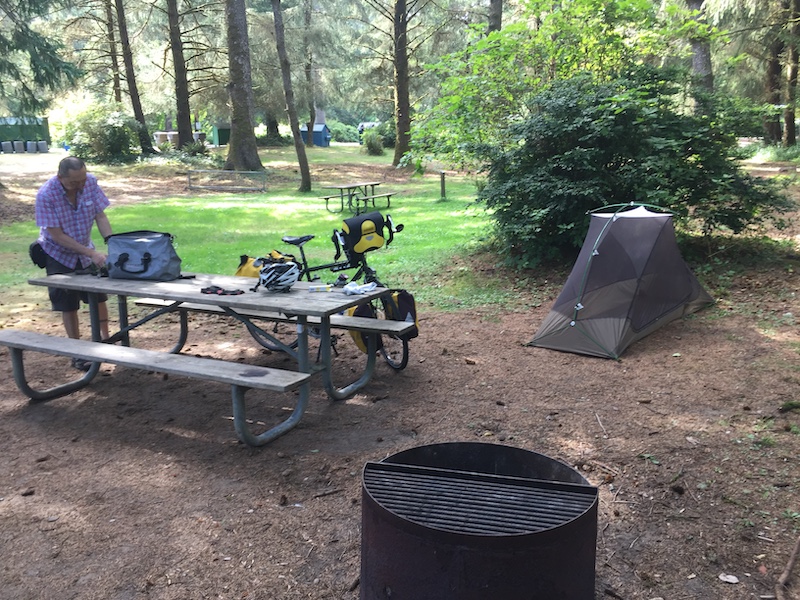 Hiker/biker campsite at Fort Stevens State Park.
Hiker/biker campsite at Fort Stevens State Park.
Lodging
Because the Oregon Coast Trail travels through 28 towns, there is a lot of lodging available along the way. You could certainly hike inn-to-inn. Although, just like with backpacking, lodging isn’t always close together, so you might have some long days.
RV Parks
There are some private RV parks that allow tent camping, and some of them are really nice. A couple of my favorite places to camp on the Oregon coast are in those private RV parks. One is called Indian Creek, in Gold Beach, OR. It’s important to note that there’s no other camping for quite a while along that part of the coast, so this place is great to know about. It’s about a mile off the Oregon Coast Trail, up the Rogue River, and it’s just a really nice. They don’t really have a hiker/biker area, so you have to either take your chances or call ahead to make a reservation.
An even better spot a little further down the coast, still in Gold Beach, is Honey Bear by the Sea RV Resort. It’s very close to the beach, and when you walk in and are instantly surrounded by RVs. You’ll walk through all the RVs, down a little road, and suddenly you’re in this beautiful wide field, bordered by a creek, that has five tent sites along the edge. You can hear the ocean. It’s so private, so quiet, and so lovely.
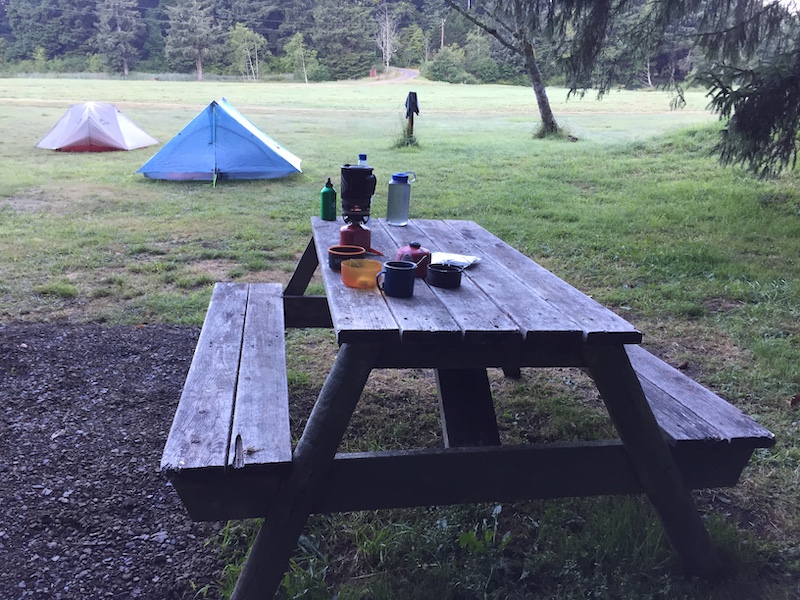 Tent camping site at Honey Bear by the Sea Campground, near Nesika Beach.
Tent camping site at Honey Bear by the Sea Campground, near Nesika Beach.
How Much Does It Cost to Thru-Hike the Oregon Coast Trail?
Thru hiking the OCT costs more than other long trails because you are often paying for camping, unlike wilderness backpacking, and you’re likely to stop in at a few restaurants or coffee shops or pubs.
If your goal is to do it on a budget, there are some great, money-saving options. For example, you should plan to stay in those affordable hiker/biker camps and do some beach camping or rough camping in the dunes. Instead of paying for boat shuttles, you might hitch a ride with a recreational boater across the bays now and then. Not including food, a thru-hike of the OCT is probably going to cost you a couple hundred dollars.
 Hiker gets boat shuttle across mouth of Tillamook Bay from the town of Garibaldi. These can cost up to $30.
Hiker gets boat shuttle across mouth of Tillamook Bay from the town of Garibaldi. These can cost up to $30.
If you add in paying for some boat shuttles, which can be anywhere from $10 to $30, budget for another hundred dollars or so. There are at least three, or possibly more along the trail. Or if you want to overnight at a nicer campground or in lodging with some amenities, naturally, that will drive up the cost a bit, too.
Then add the cost of food. You can carry food with you, but since you’re walking through towns, the option to stop and enjoy a nice treat or tasty meal is hard to resist.
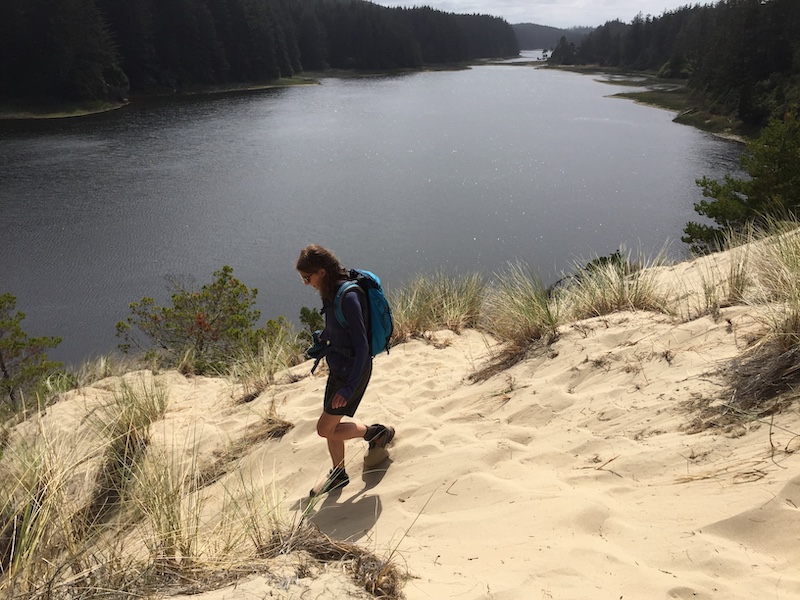 Walking toward campsite at end of Threemile Lake in Oregon Dunes National Recreation Area.
Walking toward campsite at end of Threemile Lake in Oregon Dunes National Recreation Area.
Do You Need a Permit for the Oregon Coast Trail?
You don’t need a permit to hike or backpack the Oregon Coast Trail. Some state parks charge a day-use fee, but that is only for parking, not for people hiking through.
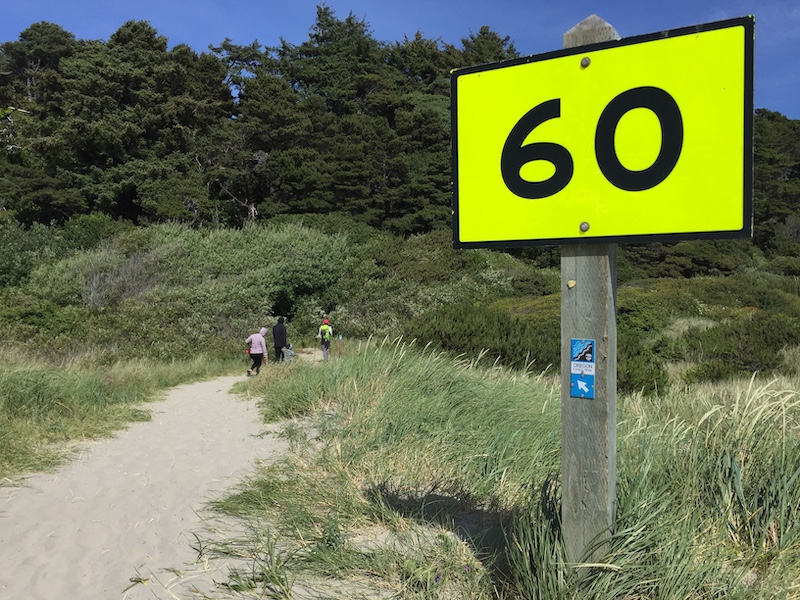 Numbered neon emergency beach access signs are helpful with wayfinding along the Oregon Coast Trail.
Numbered neon emergency beach access signs are helpful with wayfinding along the Oregon Coast Trail.
Where Do You Park for the Oregon Coast Trail?
This is complicated, because it depends on where you’re going to be. If you’re day hiking, parking is relatively easy to find at the various beaches and state parks.
The most important thing I could share is generally, overnight parking is not allowed at state parks. However, what people don’t know is, you can get a permit to park overnight at many state parks. So, I recommend contacting the state park in the area where you want to start, or wherever you want to leave a car, in advance. You may not be allowed to park exactly where you want to, but you’ll be told which nearby park you can park at instead.
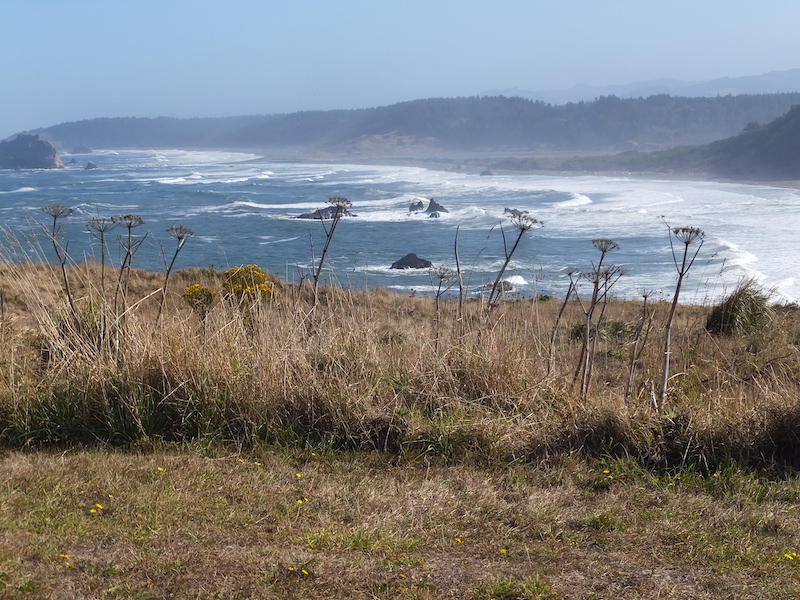 Looking north from Cape Blanco, toward Black Lock Point.
Looking north from Cape Blanco, toward Black Lock Point.
Gear Needed to Hike or Backpack on the Oregon Coast
Best Footwear for the Oregon Coast
As far as footwear, I’ve hiked the OCT in trail runners, which is also what I have worn for backpacking it in recent years. I’ve also worn lightweight, waterproof boots, and that’s what I like the best. This is mainly because there are a lot of little creeks that you have to cross. With a good pair of waterproof boots, you can just walk through them and your feet stay dry. If you’re going long distances, it’s ideal to keep your feet dry.
You might find that sand gets into your shoes. I sometimes use Dirty Girl Gaiters. They make a really nice, lightweight gaiter that people use on the Pacific Crest Trail and other places. I haven’t used them on the OCT, but I think it would probably be a really good idea.
Sleeping Bags for Backpacking the OCT
Unlike in the mountains, you don’t need a really warm sleeping bag. Nighttime temperatures won’t get much below 50 degrees in the summer. So, you can go with a very, very light sleeping bag.
Hiking the Oregon Coast with Trekking Poles
I really like hiking/trekking poles on this trail. I’ve hiked it without trekking poles and with them, and there are so many ways that trekking poles come in handy on the Oregon Coast Trail. Not to mention that they just help take some of the strain off your knees when you’re going downhill.
Sometimes they’re helpful when you’re having to wade through a river that’s pretty deep. They can help keep you upright. Or, you can use them for balance when crossing a river on a log or on rocks. There are a lot of trails on Oregon’s coast that, because the weather can be pretty rough in winter, they can get pretty gnarly in terms of rocks and roots. So, having trekking polls can really help you out.
There are so many different brands and models. I prefer the trekking poles that are set at a certain length rather than telescoping, so that you always know they’re not going to collapse on you and they’re always the height that you want.
An Oregon Coast Hiking Must-Have: Rain Gear
When hiking and backpacking on Oregon’s coast, you must have rain gear. A really good quality, lightweight rain jacket and pants are absolutely essential. In the summer you’re probably not going to need rain gear much, but when it gets nasty… I’ll share a story. My friends had one day when it rained nonstop, and it was a day that they had to cross two rivers. That was pretty unusual. It was beautiful the day before and the day after, but, you know, it’s just essential to be prepared.
One of the things that I’ve noticed is the quality of the ultralight, waterproof and breathable rain jackets has really gone up and the price has gone down. They’re not as expensive as they used to be. You used to have to pay a lot of money for a heavy and overbuilt Gore-Tex rain jacket. These days you can get one that’s much lighter, very packable, and isn’t that expensive.
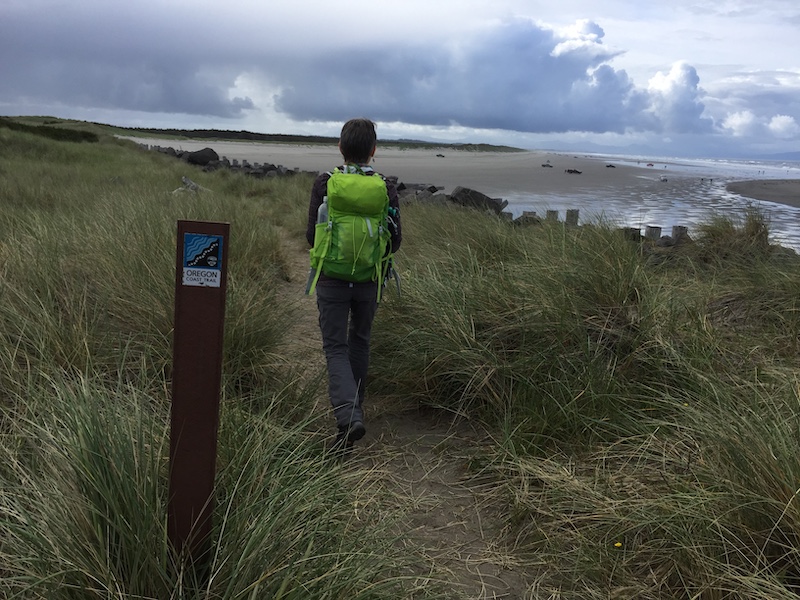 Beginning of Oregon Coast Trail on the south jetty of the Columbia River.
Beginning of Oregon Coast Trail on the south jetty of the Columbia River.
About Bonnie Henderson
I am just very fond of the Oregon Coast Trail, and the coast in general. I spent some time as a volunteer with CoastWatch, which is a program of Oregon Shores Conservation Coalition. You adopt a mile of coastline and go there on a regular basis to make sure it’s in good shape; report changes, natural or otherwise; and stay aware of any proposals for land-use changes. Actually, my involvement as a CoastWatch volunteer led to my writing a book called Strand: An Odyssey of Pacific Ocean Debris.
I also volunteer with North Coast Land Conservancy, which has a great fundraiser every September called CoastWalk Oregon. Over three days they lead hikers on three consecutive 10-mile stretches of the Oregon Coast Trail. People love it: it fills up very quickly. The people who have the most fun on it are people who train methodically; a lot of people who regularly hike 4 or 5 miles don’t realize how much more challenging a 10-mile day hike is, especially if it involves some elevation gain. Having a training program like that offered by Fit for Trips makes it a much better experience.
When you’re constantly visiting a particular place on the Oregon coast, you realize how much it changes over time. These coastal areas might not change too much or look different from season to season or year to year, but you start to realize how much it really does change. I think this encourages you to pay more attention to your surroundings. When you’re involved in some of these conservation groups and revisiting the land to take notes, you’re just more observant and more appreciative.
I will say, I’ve become drawn to the notion that everything feels fresh and new when I hit the trails, whether I’m hiking near home in Eugene or exploring a new place. Because of this, the cool thing about hiking is it’s truly a lifelong activity. There’s always something new to see, it’s easy to train for, and it’s so rewarding.
